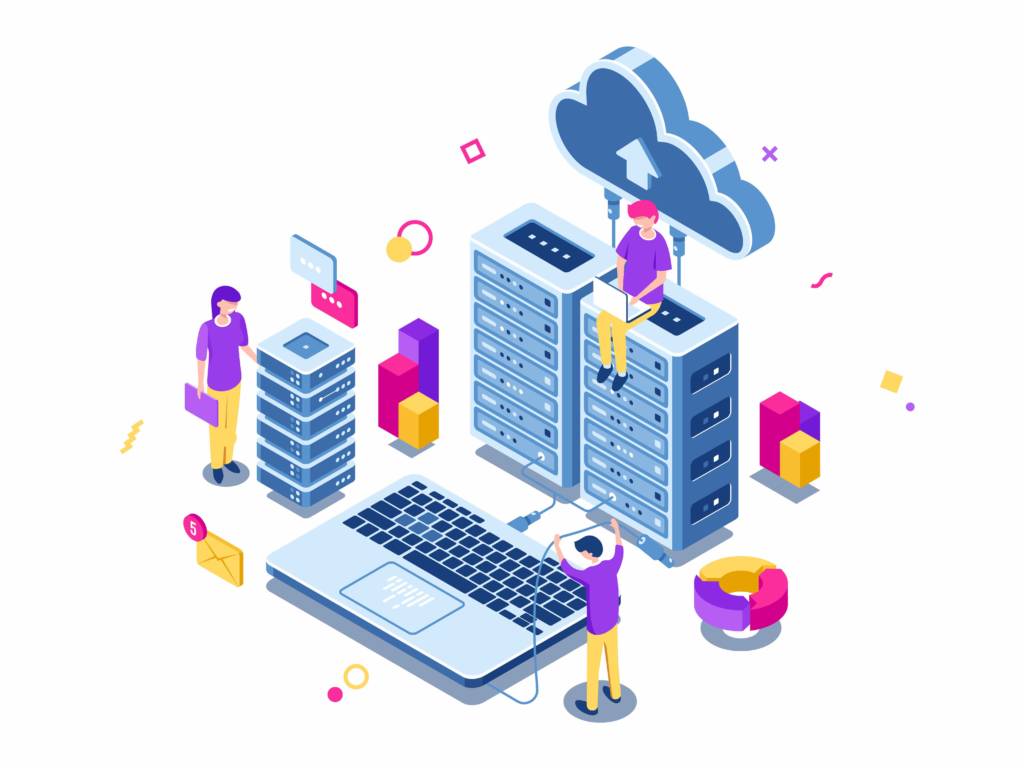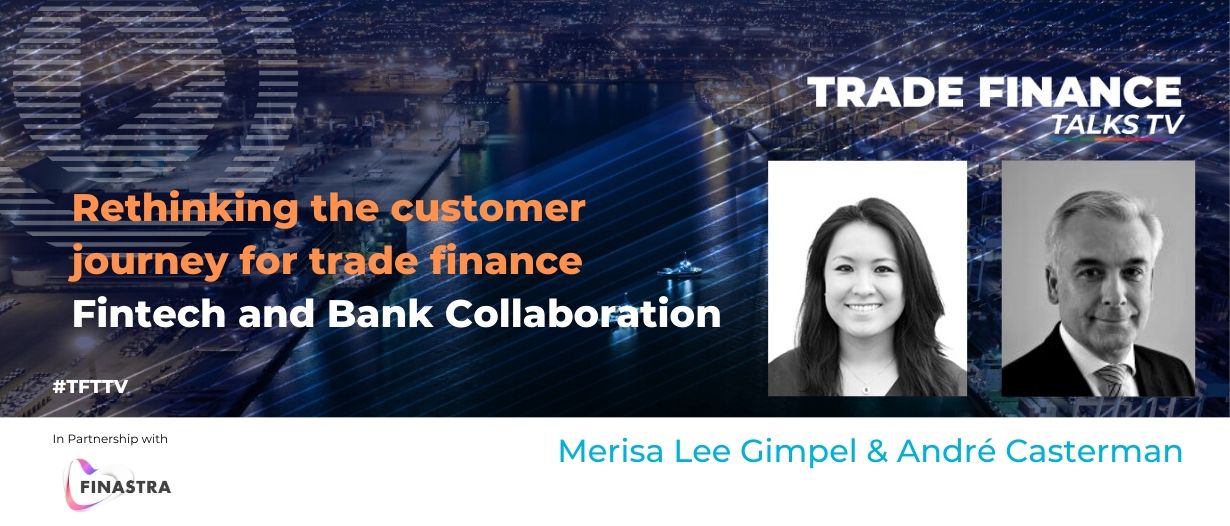How do fintechs work with banks, and how can we rethink the customer journey for trade finance? TFG partnered up with Finastra to discuss how fintechs and banks collaborate, how the onboarding process works, and the advantages fintechs can offer to the end corporate client. A TFG exclusive, filmed at Finastra’s offices, with Merisa Lee Gimpel, Head Trade Innovation, GTB, Lloyds Banking Group and Andre Casterman, ITFA Board Member, Chair of the ITFA Fintech Committee.
Featuring: Andre Casterman, ITFA Board Member and Chair of the ITFA Fintech Committee, ITFA
Merisa Lee Gimpel, Director, Head of Trade Innovation, Global Transaction Banking, Lloyds Banking Group
Host: Deepesh Patel, Editor, Trade Finance Global
Are banks opening up to fintech collaboration and do you see a future for fintech-to-fintech collaboration?
Andre Casterman: There is an intensifying collaboration between incumbent financial institutions and fintechs and I believe this trend is here to stay. We see already short term results from this collaboration. This is coming from the fact that basically fintechs are very specialised, they are coming with value propositions that are addressing very specific pain points. They are not trying to change the way the back office runs. They are trying to add capabilities to look the back office, add capabilities to the front office and working with those players like financial institution’s back office vendors and channels, that are in place. And this preparation extends beyond the bank fintechs relationship it goes into the technology and relationship where niche fintech players highly specialised, as I said, start collaborating with the large trade finance vendors like Finastra, and that is again to address very specific pain points, such as document checking, which is key in the back office function. And again, the technology integrates nicely with the tools that operations teams use today. Another example of fintech-fintech collaboration is where new technology players like those on the document technology, like Enigio Time, start working with funding platforms to digitise promissory notes and bills of exchange. So this is all very good for the whole market. And definitely, we’re going to see more and more results in the next 12 to 18 months
Merisa Lee Gimpel: At Lloyds Bank, we launched a survey very recently asking the top 100 leaders in the financial institutions space – if you were to work with fintechs, what would you say your number one challenge is – and the word interoperability came up. So that is really the biggest challenge we would love to work with fintechs to answer very niche, unique pain points, the challenge and the question is how do we integrate that into our existing infrastructure on the technology side, and that’s something that we would love to collaborate and work on.
Andre Casterman: Exactly. That’s where API’s, data specifications, make it happen. We’ve seen at Sibos recently, how banks are embracing APIs for trade finance building on their experience on the payment side. And this is how also fintechs will collaborate with each other beyond the fintech integration in the bank’s back-office environment.
Fintechs and the ever changing expectations in trade finance
How do banks view fintechs, and how do you choose which ones to partner with?
Merisa Lee Gimpel: As we see trade undergoing massive disruption and change, a lot of it is powered by fintechs changing the way our clients are expecting things to get delivered. At Lloyds Bank, our mission is to ‘Help Britain Trade’, and as part of that, we put our customer needs at the centre of it all. And we’re very open to partnerships, whether that’s with fintech or traditional tech companies or other banks, as long as it delivers value for customers. If it delivers value, then the question is not whether we should partner with a fintech, but how do we do so. And we are working closely with fintechs and also internally ourselves to make sure that we can bring relevant solutions quicker to market for our clients. And that includes things like looking into how we have a more nimble onboarding process as we work with partners like fintechs. We’re very proud to say that we continue to improve the onboarding process. We have been able to onboard a trade fintech in under two months, which is a massive kind of speed to market in this space.

Fintechs helping banks provide more value to corporates
What advantages do fintechs offer to financial institutions and their corporate clients?
Andre Casterman: The trade finance businesses is very established, very standardised. So for financial institutions to differentiate, it’s all about depth and breadth of services, combining trade services with payment services with FX services. Now, what is happening with technology is that and with particular fintech players, indeed, is that some processes that are still very manual, very paper-based and not automated, for those reasons are going more and more through a digitization journey. Even if the LC is still initiated on paper, the trade back-office people within financial institutions can rely on technology to digitise the documents and to apply the ICC rules on the documents. That’s document checking technology offered, for instance by Traydstream and that is accelerating the bank’s operations and helping the corporates reduce their day sales outstanding because they’re getting paid faster by the bank when older documents are checked. Another benefit for corporates is to use platforms where they can find new financing providers, new funders for their activities. So I think all of those fintech trends are addressing the outstanding pain points of paper, of lack of digitization, lack of automation, and bringing actually the very latest technologies and I’m thinking about using transaction data, historic data, as well as machine learning in order to automate and accelerate those processes.
Merisa Lee Gimpel: And at Lloyds Bank, we put the customer at the centre of it all. So we put the customer at the centre of our design journey. It has to be always about the customers’ biggest pain points. And when we talk about customers, we’re not talking about inanimate corporations. Even in the commercial banking space, customers are humans. And humans have fears. They have wishes. They have pain points, irritations, and they have moments of joy. And that’s what we bring into our innovation space. So we’re constantly talking to our clients trying to understand their needs, constantly getting validation or invalidation on our trade innovation projects. Because at the end of the day, I think our CEO says it really well. Antonio, he says: we want machines to do the ordinary so that humans can do the extraordinary. And those humans are the people, our colleagues working at Lloyds Bank in Trade, and those humans are our clients as well. So we definitely look forward to what technology can give and deliver, but always to empower humans, whether it’s the human experience, or making things simpler, more secure, and on the timelines that our customers want it so not everything has to be quick. And if technology can deliver that then all the better.

Addressing the specific pain points
How closely do you (as a bank) collaborate with your corporate customers in the area of innovation?
If a corporate comes to us at Lloyds Bank and says I want to work with this fintech, how do we approach it? We always value what our customers are asking for. And we will go back to what is the challenge that our customer needs to get fixed, and we see that in the channels space. So if they say “we want to work with this provider because it helps solve X Y Z need” we’ll definitely listen to them. And we prioritise our innovation projects based on customer needs and customer demand. In most cases, the majority of the fintechs I speak with are answering very niche needs, so we don’t have our corporate clients saying: yes, Merisa, we want you to work with this fintech or that fintech. We have to unbundle it and look at what is the “hair on fire” or the big pain point that these fintechs are addressing. And we match it to the pain points that our customers have expressed that they have, whether that is they want to deal more securely, whether that is they want to eliminate all that paperwork and manual processing, in how they issue letters of credit, for example, and we match that with the right fintech for that solution. That’s how we prioritise. So when I talk to fintechs, there are two things I asked them: what is the hair on fire problem (pain point) that you’re trying to solve for my clients. And number two, what about your solution stands you apart from the alternatives? And because this is a rather new space, the alternatives might not be just another fintech. It definitely could be the current way of doing things, which is well, it’s paper, we’re going to use paper, we’re going to go back to that comfort zone of working how we’ve always done trade finance for hundreds of years. And we need them to give a very compelling reason how their solution helps us move away from that and convince our clients – give value to our clients – so that they also move away from the current way of doing things.

































